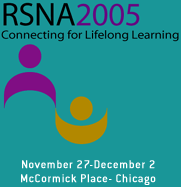
Abstract Archives of the RSNA, 2005
R Desmond Kidd MD, Abstract Co-Author: Nothing to Disclose
Jean Solano BS, Abstract Co-Author: Nothing to Disclose
Lori Lee Barr MD, Presenter: Nothing to Disclose
Purpose: To prospectively test diagnostic accuracy of a rapid CT scanning protocol of the abdomen and pelvis without oral contrast (OCT) administration against the more time- consuming process of oral contrast administration to expedite diagnosis of acute appendicitis.
Materials and methods: Children ages 7 mos-16 yrs (mean 8 yrs) with acute abdominal pain presenting January-June 2004 were prospectively scanned using low-dose helical CT (Siemens 4 slice multi-detector scanner) and 1 of 2 protocols based on successful placement of a 22G IV in the arm. Successful IV placement permitted immediate IV contrast-enhanced abdominal and pelvic scanning. If not, the patient received OCT over 1 hour, IV contrast administration and scanning. All cases interpreted by board certified radiologists at the time of exam. Sensitivity, and specificity were calculated with true positive diagnosis of surgically proven appendicitis and true negative diagnosis of no repeat visit to the hospital within 48 hours. Secondary review of images and medical records was performed by pediatric radiologists.
Results: 107 scans were performed on 100 patients enrolled. Surgically proven appendicitis was found in 25 patients with 86/107 scans performed without OCT and 21 performed with OCT. Sensitivity and specificity without OCT were 100% and 95% respectively; with OCT 100% and 94%. Three patients originally scanned without OCT had repeat scans within 24 hours with OCT. All 3 were true negatives with no change in CT diagnosis between scans. Identification of the appendix was not necessary for accurate diagnosis in either group. Unmeasured outcomes since the study closed are increased clinician, patient and parent satisfaction and decreased room times to the point that the scanning protocol is widely utilized for children at hospital and outpatient imaging sites with 4-slice or greater multi-detector scanners within our community.
Conclusion: In children with acute abdominal pain rapidly scanned using multi-detector scanner and helical low-dose technique, oral contrast material administration makes no difference in detection of acute appendicitis whether or not the appendix is identified.
Kidd, R,
Solano, J,
Barr, L,
Pediatric Appendicitis: Expediting a Diagnosis. Radiological Society of North America 2005 Scientific Assembly and Annual Meeting, November 27 - December 2, 2005 ,Chicago IL.
http://archive.rsna.org/2005/4420485.html

